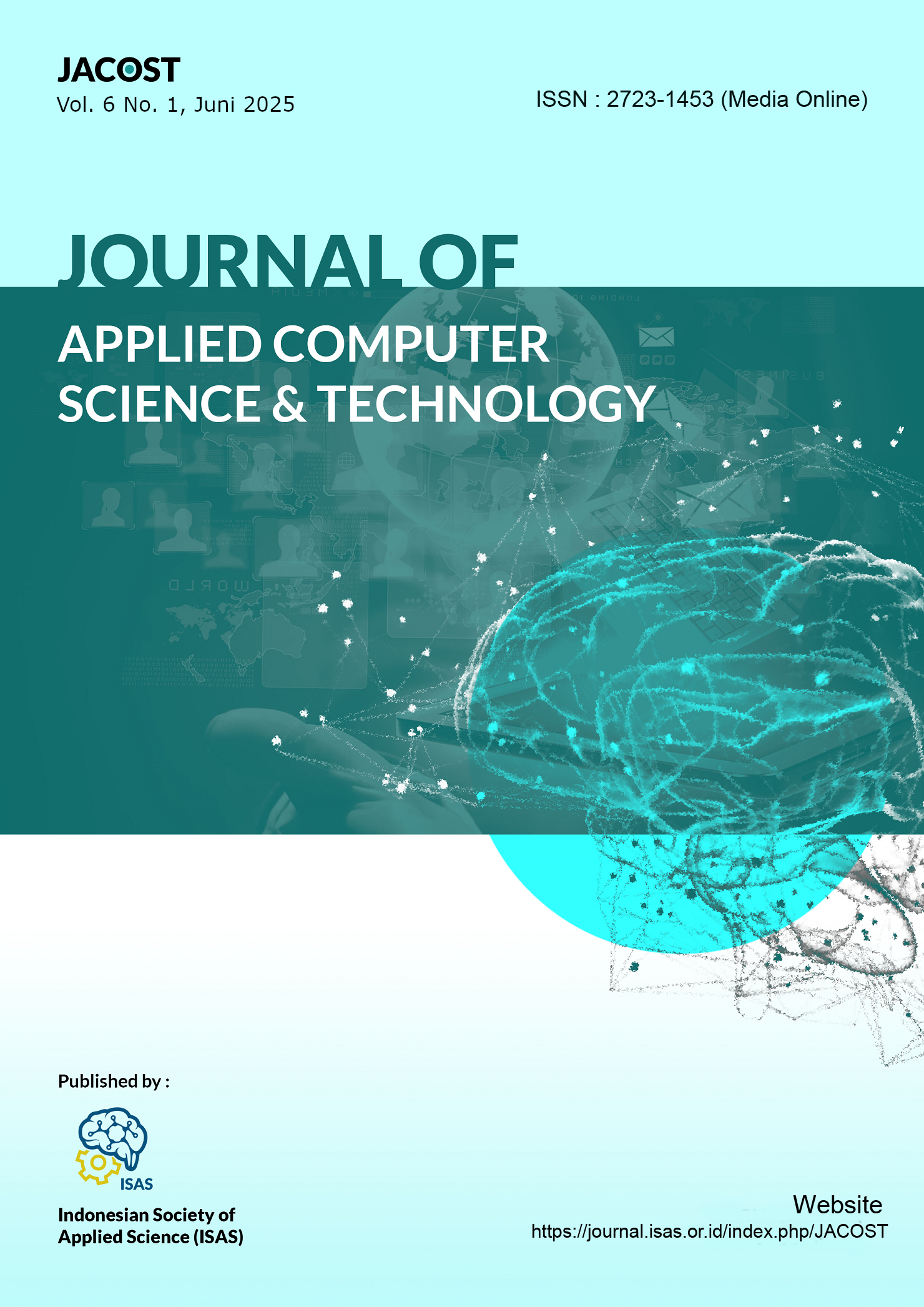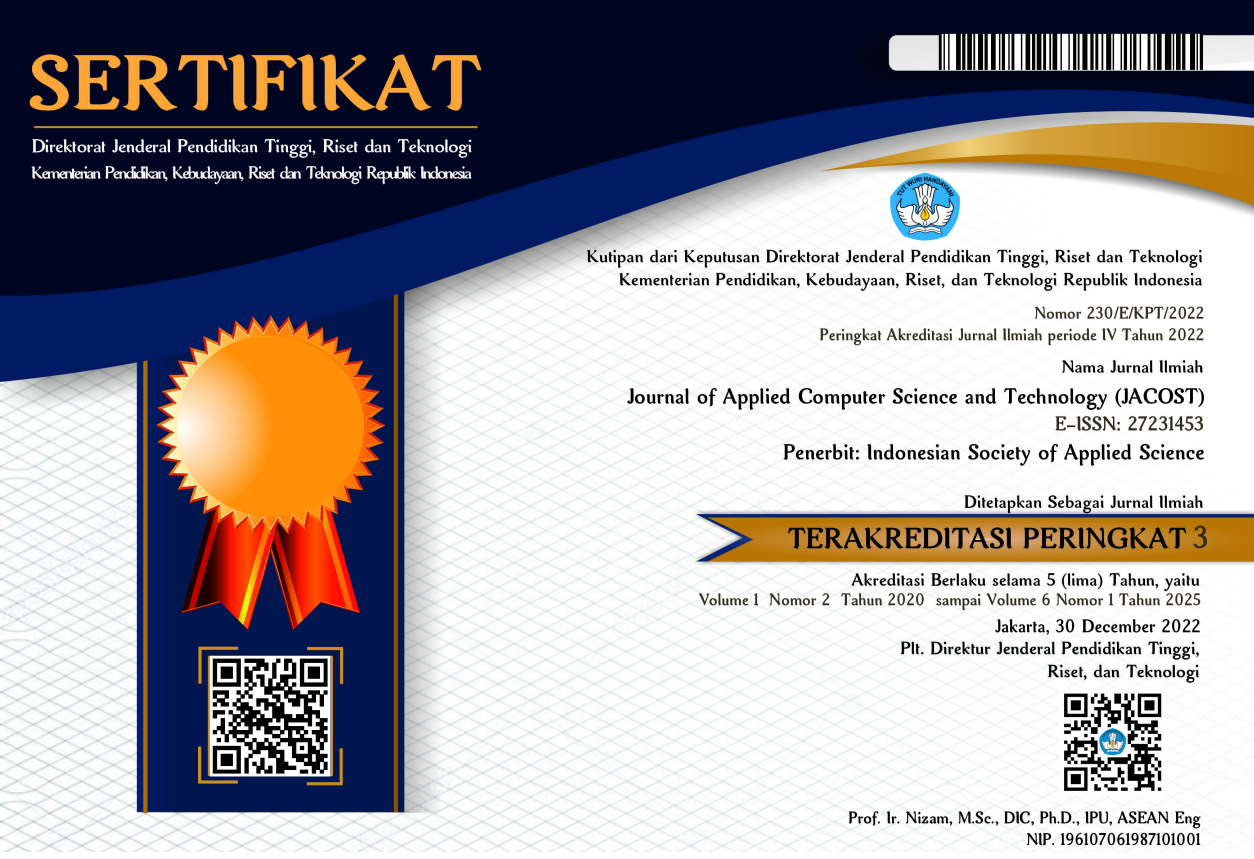Konsistensi Model Regresi Empat Variabel Pada Populasi dan Sampel untuk Prediksi Temperatur
DOI:
https://doi.org/10.52158/jacost.v6i1.971Keywords:
Multi Variable Linear Regression, Population, sample, Slovin, RMSEAbstract
The ability to predict future events or trends has become very important today. One method that can be used to predict the future is to use linear regression. Accurate regression modeling requires sampling representative data, especially when working with large datasets. This research takes a relatively large volume as a data set by looking at the accuracy and consistency of the coefficients of a multi-variable linear regression model for temperature prediction which is built based on all the data, and looks at the differences in the regression model built from the sample data. The number of sample data (n) is determined based on the Slovin formula which depends on the number of population data (N) and the level of confidence (ơ), so that as many as (N/n) new regression models can be built. Each group of sample data is divided into 75% for modeling and 25% testing data. The dataset used is weather information in the Szeged area which was measured in 2006 - 2016. So the regression model is in the form of Y (temperature value) which is influenced by Xi (weather factors), namely humidity, wind speed, wind direction and visibility. Using 96,453 data records and a 1% significance level in Slovin's formula, 10 samples were generated. Nine out of ten sample regression models agree with the population model, with positive coefficients for visibility and wind direction and negative values for humidity and wind speed. There is an abnormality in sample #4. While the other nine sample regression models are consistent with positive R2 values, Sample #1 displays an oddity with negative values. The RMSE interval values for each regression model in this study fall between 4.334 and 9.582.
Downloads
References
KBBI, “KBBI.” Accessed: Jul. 01, 2024. [Online]. Available: https://kbbi.web.id/prediksi
D. Bai, L. Ye, Z. Yang, and G. Wang, “Impact of climate change on agricultural productivity: a combination of spatial Durbin model and entropy approaches,” Int J Clim Chang Strateg Manag, vol. 16, no. 4, pp. 26–48, Jan. 2024, doi: 10.1108/IJCCSM-02-2022-0016.
BMKG Kotawaringin Timur, “Buletin Meteorologi,” Jun. 2024. Accessed: Jul. 01, 2024. [Online]. Available: https://stamet-kotim.bmkg.go.id/wp-content/uploads/2024/06/Buletin-Juni-2024.pdf
BMKG, “Visibility.” Accessed: Jul. 02, 2024. [Online]. Available: https://maritim.bmkg.go.id/glossaries/55/Visibility
Kementerian Perhubungan, “Peraturan Menteri Perhubungan Nomor 18 Tahun 2010.” Accessed: Jul. 02, 2024. [Online]. Available: https://peraturan.bpk.go.id/Details/104835/permenhub-no-18-tahun-2010
K. Qu, “Research on linear regression algorithm,” MATEC Web of Conferences, vol. 395, p. 01046, May 2024, doi: 10.1051/matecconf/202439501046.
N. Karna, P. Roy, and S. Shakya, Temperature Prediction using Regression Model. 2021.
“New Regression models for Estimation daily temperature of Karachi and its Neural Network analysis,” Global NEST Journal, Oct. 2021, doi: 10.30955/gnj.003953.
A. Luthfiarta, A. Febriyanto, H. Lestiawan, and W. Wicaksono, “Analisa Prakiraan Cuaca dengan Parameter Suhu, Kelembaban, Tekanan Udara, dan Kecepatan Angin Menggunakan Regresi Linear Berganda,” JOINS (Journal of Information System), vol. 5, pp. 10–17, May 2020, doi: 10.33633/joins.v5i1.2760.
E. Fitri, “Analisis Perbandingan Metode Regresi Linier, Random Forest Regression dan Gradient Boosted Trees Regression Method untuk Prediksi Harga Rumah,” Journal of Applied Computer Science and Technology, vol. 4, pp. 58–64, Jul. 2023, doi: 10.52158/jacost.v4i1.491.
Z. Liu and A. Zhang, A Survey on Sampling and Profiling over Big Data (Technical Report). 2020.
G. Adhikari, “Calculating the Sample Size in Quantitative Studies,” Scholars’ Journal, pp. 14–29, Dec. 2021, doi: 10.3126/scholars.v4i1.42458.
I. Gupta, H. Mittal, D. Rikhari, and A. K. Singh, “MLRM: A Multiple Linear Regression based Model for Average Temperature Prediction of A Day,” Mar. 2022.
Tedja Diah Rani Octavia, Neny Rosmawarni, Ati Zaidiah, and Nunik Destria Arianti, “Implementation of Multiple Linear Regression Algorithm to Predict Air Temperature Based on Pollutant Levels in South Tangerang City,” Jurnal Inotera, vol. 9, no. 2, pp. 378–390, Aug. 2024, doi: 10.31572/inotera.Vol9.Iss2.2024.ID383.
H. A. Y. Ahmed and S. W. A. Mohamed, “Rainfall Prediction using Multiple Linear Regressions Model,” in 2020 International Conference on Computer, Control, Electrical, and Electronics Engineering (ICCCEEE), IEEE, Feb. 2021, pp. 1–5. doi: 10.1109/ICCCEEE49695.2021.9429650.
Mohammad Mahbobi and Thomas K.Tiemann, Introductory Business Statistics with Interactive Spreadsheets - 1st Canadian Edition, 1st ed. BCcampus, 2010.
S. G. Patro, P. Sahoo, I. Panda, and D.-K. K. Sahu, “Technical Analysis on Financial Forecasting,” Mar. 2015.
D. Anggoro and W. Supriyanti, “Improving Accuracy by applying Z-Score Normalization in Linear Regression and Polynomial Regression Model for Real Estate Data,” International Journal of Emerging Trends & Technology in Computer Science, pp. 549–555, Nov. 2019, doi: 10.30534/ijeter/2019/247112019.
D. Chicco, M. J. Warrens, and G. Jurman, “The coefficient of determination R-squared is more informative than SMAPE, MAE, MAPE, MSE and RMSE in regression analysis evaluation,” PeerJ Comput Sci, vol. 7, p. e623, Jul. 2021, doi: 10.7717/peerj-cs.623.
A. Jadon, A. Patil, and S. Jadon, “A Comprehensive Survey of Regression Based Loss Functions for Time Series Forecasting,” Nov. 2022.
S. D. Latif, “Developing a boosted decision tree regression prediction model as a sustainable tool for compressive strength of environmentally friendly concrete,” Environmental Science and Pollution Research, vol. 28, no. 46, pp. 65935–65944, Dec. 2021, doi: 10.1007/s11356-021-15662-z.
A. Mekoya, “Estimation of Evaporation at Tharandt, using Daily and Ten-Minute Class-A Pan Data from Automatic Measuring Pressure Sensor Instrument,” International Journal of Environmental Sciences & Natural Resources, vol. 19, no. 1, Apr. 2019, doi: 10.19080/IJESNR.2019.19.556003.
Norbert Budincsevity, “Weather in Szeged 2006-2016,” https://www.kaggle.com/datasets/budincsevity/szeged-weather. Accessed: Jul. 01, 2024. [Online]. Available: https://www.kaggle.com/datasets/budincsevity/szeged-weather
D. Chicco, M. J. Warrens, and G. Jurman, “The coefficient of determination R-squared is more informative than SMAPE, MAE, MAPE, MSE and RMSE in regression analysis evaluation,” PeerJ Comput Sci, vol. 7, p. e623, Jul. 2021, doi: 10.7717/peerj-cs.623.
Downloads
Published
Issue
Section
License
Pernyataan Hak Cipta dan Lisensi
Dengan mengirimkan manuskrip ke Journal of Applied Computer Science and Technology (JACOST), penulis setuju dengan kebijakan ini. Tidak diperlukan persetujuan dokumen khusus.
- Hak cipta pada setiap artikel adalah milik penulis.
- Penulis mempertahankan semua hak mereka atas karya yang diterbitkan, tak terbatas pada hak-hak yang diatur dalam laman ini.
- Penulis mengakui bahwa Journal of Applied Computer Science and Technology (JACOST) sebagai yang pertama kali mempublikasikan dengan lisensi Creative Commons Atribusi 4.0 Internasional (CC BY-SA).
- Penulis dapat memasukan tulisan secara terpisah, mengatur distribusi non-ekskulif dari naskah yang telah terbit di jurnal ini kedalam versi yang lain (misal: dikirim ke respository institusi penulis, publikasi kedalam buku, dll), dengan mengakui bahwa naskah telah terbit pertama kali pada Journal of Applied Computer Science and Technology (JACOST);
- Penulis menjamin bahwa artikel asli, ditulis oleh penulis yang disebutkan, belum pernah dipublikasikan sebelumnya, tidak mengandung pernyataan yang melanggar hukum, tidak melanggar hak orang lain, tunduk pada hak cipta yang secara eksklusif dipegang oleh penulis.
- Jika artikel dipersiapkan bersama oleh lebih dari satu penulis, setiap penulis yang mengirimkan naskah menjamin bahwa dia telah diberi wewenang oleh semua penulis bersama untuk menyetujui hak cipta dan pemberitahuan lisensi (perjanjian) atas nama mereka, dan setuju untuk memberi tahu rekan penulis persyaratan kebijakan ini. Journal of Applied Computer Science and Technology (JACOST) tidak akan dimintai pertanggungjawaban atas apa pun yang mungkin timbul karena perselisihan internal penulis.
Lisensi :
Journal of Applied Computer Science and Technology (JACOST) diterbitkan berdasarkan ketentuan Lisensi Creative Commons Atribusi 4.0 Internasional (CC BY-SA). Lisensi ini mengizinkan setiap orang untuk :.
- Berbagi — menyalin dan menyebarluaskan kembali materi ini dalam bentuk atau format apapun;
- Adaptasi — menggubah, mengubah, dan membuat turunan dari materi ini untuk kepentingan apapun.
Lisensi :
-
Atribusi — Anda harus mencantumkan nama yang sesuai, mencantumkan tautan terhadap lisensi, dan menyatakan bahwa telah ada perubahan yang dilakukan. Anda dapat melakukan hal ini dengan cara yang sesuai, namun tidak mengisyaratkan bahwa pemberi lisensi mendukung Anda atau penggunaan Anda.
-
BerbagiSerupa — Apabila Anda menggubah, mengubah, atau membuat turunan dari materi ini, Anda harus menyebarluaskan kontribusi Anda di bawah lisensi yang sama dengan materi asli.

















